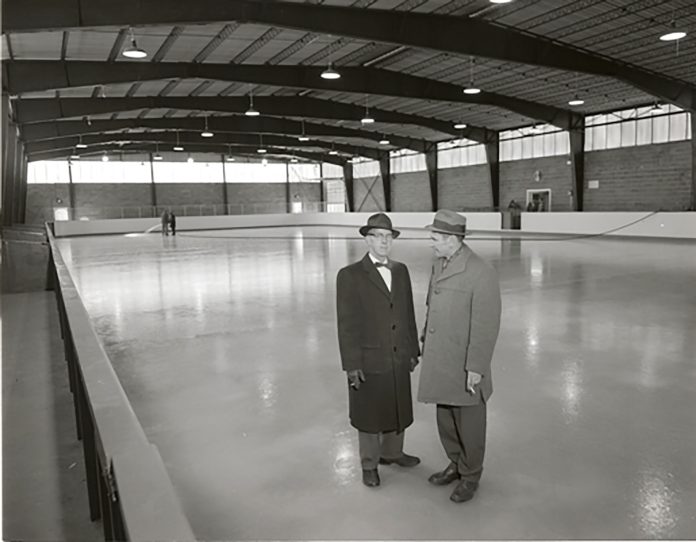By Dave Allston
One of Kitchissippi’s hidden gems is Lions Park, a recreational outdoor park, indoor facility and, most importantly, a community hub for nearly 75 years.
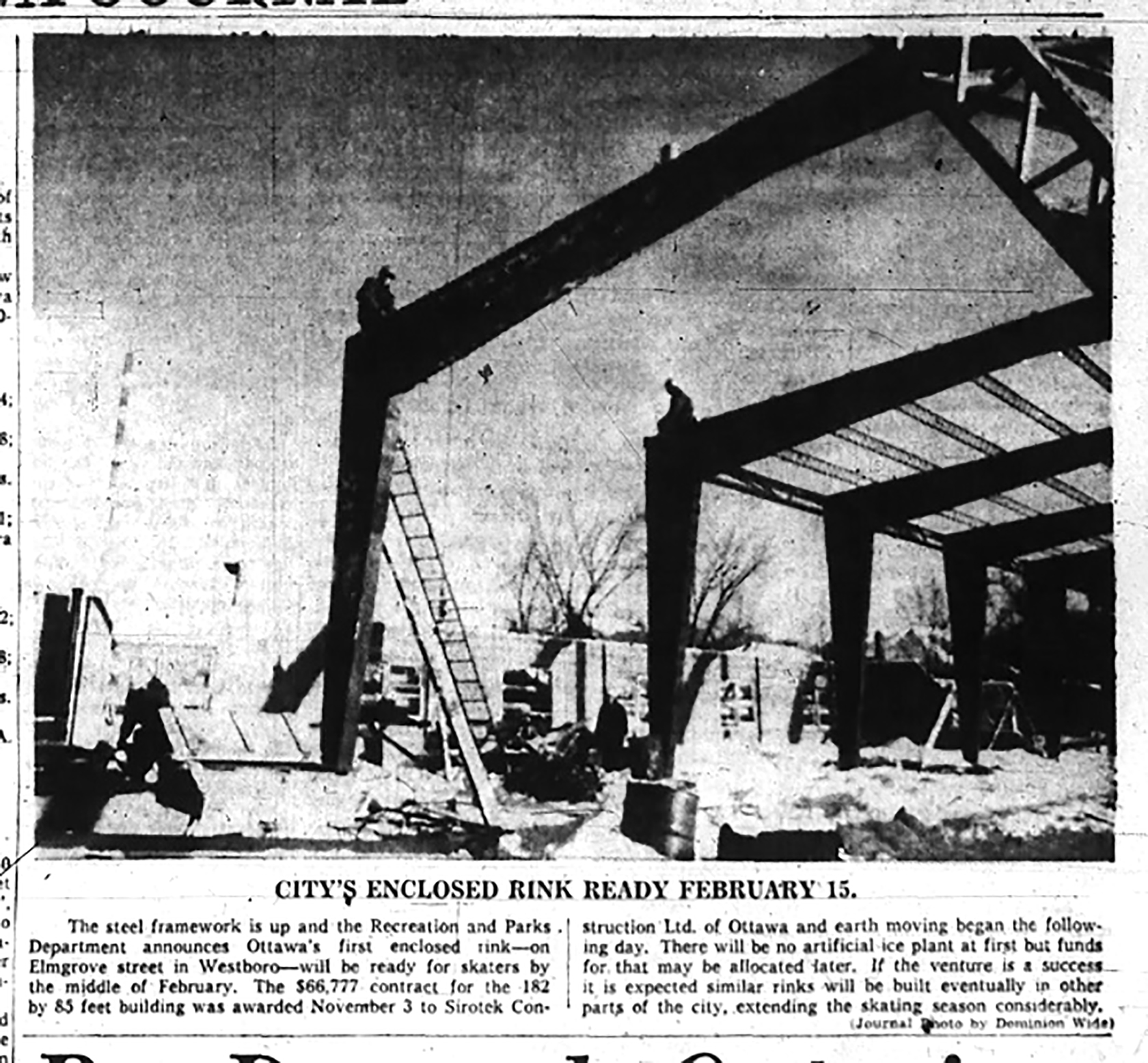
The site features a building that holds the distinction of being Ottawa’s first publicly owned indoor rink facility (Elmgrove Arena), which is now home to Canada’s oldest operating not-for-profit gymnastics organization, the Ottawa Gymnastics Centre. This same property was also one of Westboro’s first homesteads, a small farm occupied by the daughter of the pioneer Birch family, Elizabeth, (who arrived in the area in 1838) and her husband, William George Wilton.
As the patchwork of Westboro’s neighbourhoods came together through the gradual subdivision of farmland and vacant land parcels, so too did the little community of three streets running east off Winona between Scott and Richmond, the 1899 subdivision of retired former Westboro postmaster, constable, storekeeper, and baker, John Falls. Falls laid out these small streets to the edge of his property, which adjoined the Wilton-Birch property; the latter of which would never be subdivided, a rarity as Westboro grew and grew in the early 20th century.
Elizabeth Birch died in 1881, and a year later her husband lost their property to foreclosure. It went through multiple hands, never being developed or built on, until finally being surrendered to the Nepean Township due to unpaid taxes during the depression. (It’s incredible to think that this land, now worth many millions, was lost over a matter of $651.)
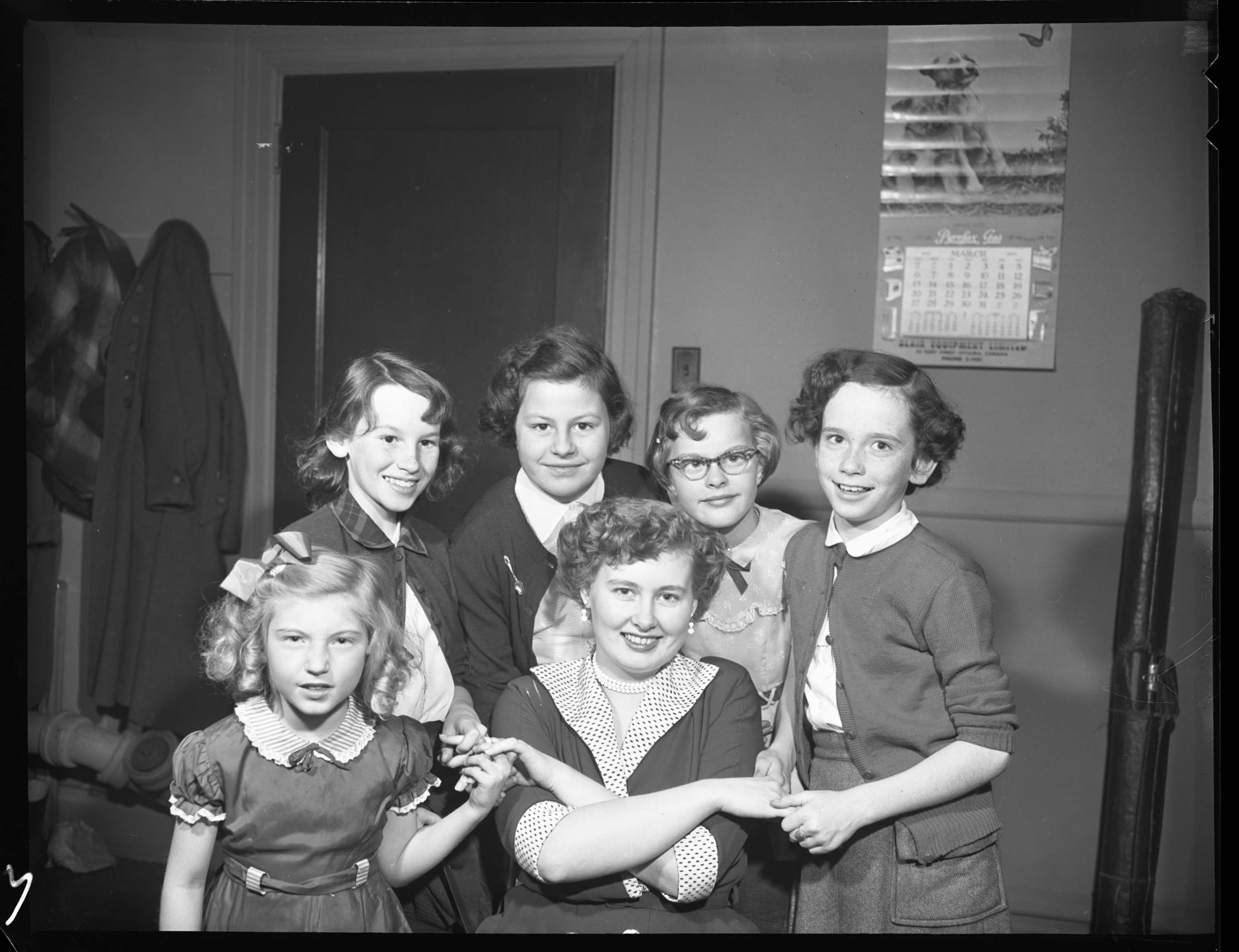
PUSH FOR GREENSPACE
By 1944, Nepean Township began to feel a push by residents to establish more recreational space, particularly parks and playgrounds. Local associations, school boards and parent groups urged Nepean to open rinks in the winter, and pools and parks in the summer. A few years later, as annexation to Ottawa loomed, Nepean would actually be required to establish park space as part of the deal. (McKellar Park being one such site, where land had to be acquired in order to fulfill the terms of the deal.)
After a year or so of debate, Nepean announced in December 1945 that they would create three outdoor skating rinks at Champlain Park, Woodroffe and Nepean High (with the one at Nepean High geared towards hockey). For whatever reason, the rink at Nepean did not materialize and, perhaps in lieu of that rink, in 1946 it was announced that a park and rink would be established at the end of Elmgrove Avenue, in the old rocky, thickly tree-covered Wilton-Birch property.
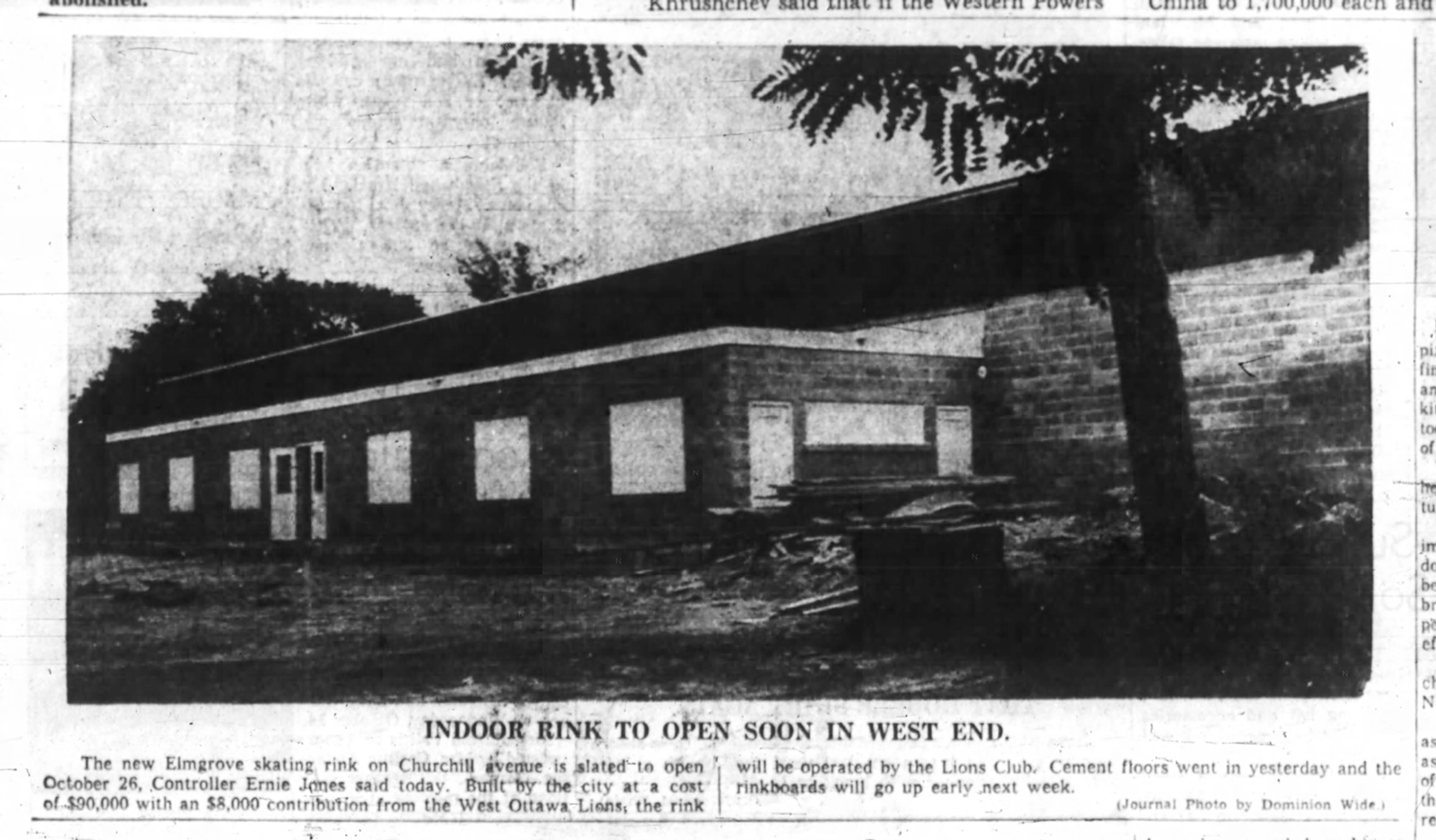
Nepean cleared the land in 1946, in time for the new Elmgrove Park and outdoor rink to be opened later that year. Elmgrove, along with Champlain Park (then still known as Riverside Park), became the first two outdoor rinks operated by the Township that winter.
Elmgrove Park was improved bit by bit each summer in the late 1940s. A long, thin wood building was constructed at the east end of the park in 1947, to serve as dressing room facilities, and a baseball diamond, playground and swings were added in 1948.
However, it was the two immaculately maintained outdoor rinks which brought the neighbourhood to Elmgrove Park, particularly in the winter, with busy hockey leagues and the annual winter carnival from the late 1940s into the 1960s drawing thousands of residents from Westboro and beyond.
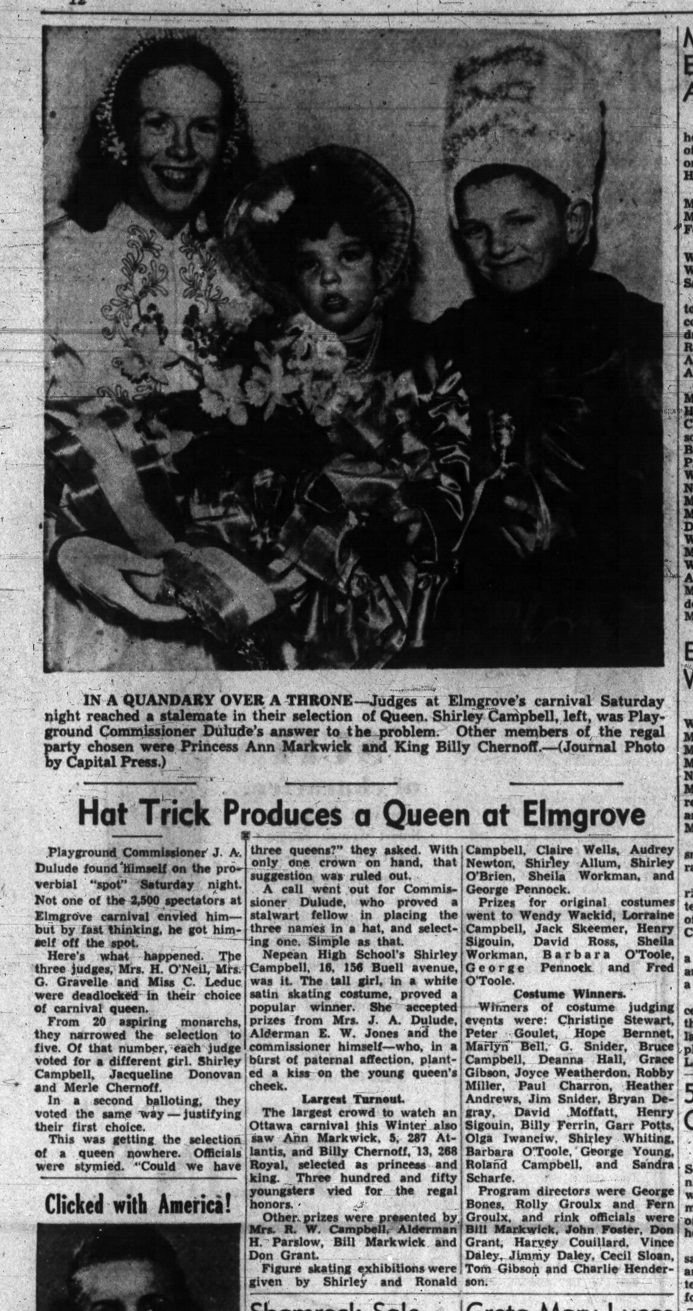
In 1953, a portion of the property was divided off and sold to a group of Westboro residents interested in establishing a curling club, which they did with the opening of the Granite Curling Club in February of 1954.
The City of Ottawa was under heavy pressure to establish more sports facilities in its urban neighbourhoods (Elmgrove Park had become part of Ottawa when Nepean was annexed in 1950). So, in 1958, Elmgrove was deemed the ideal place for the construction of Ottawa’s first enclosed ice rink! The $73,000 plan, for which City Recreation Commissioner J. Alph Dulude was a strong proponent, was made possible through a joint agreement between the City and service clubs of Westboro.
Initially the City was allocating $35,000 from its capital budget for the project, but required the remainder to come from community organizations in Westboro, who in turn would be allowed “to use the building for their own purposes from time to time and sell tickets of admission”. Some members of the Board even felt that recreation facilities were in greater need in other areas of the city, but it was noted that there were no sites available in central areas, and that the Elmgrove location was a prime one, which should be taken advantage of.
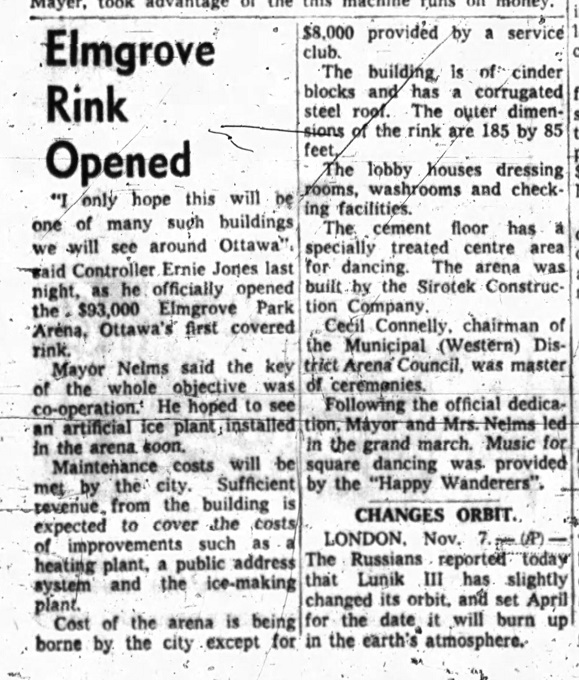
In the end, the City retained the original plan, and further kept things simple by allocating an additional $30,000 from a special fund, requiring only $8,000 from the community. The contribution was provided in full by the West Ottawa Lions Club, towards the interior facilities (dressing rooms and bleacher seating).
Sirotek Construction was awarded the contract to build the arena, and construction began in December 1958. Anticipated to be completed in early 1959, the project was not completed until late in the year, largely owing to concerns over the roof (incidents during arena construction in other parts of Ontario in the late 1950s prompted additional detail to be put in to the roof design). The final cost had ballooned to $93,000, but Elmgrove Arena opened to great fanfare on November 6, 1959. The first night of skating was held on December 23, interestingly with natural ice (the artificial ice plant did not get put in to use until sometime after).
In April 1966, the City acknowledged the efforts of the West Ottawa Lions Club, not only in their contribution to its construction but for their years of volunteer-led ticket selling and taking, skating lessons and canteen operation, by renaming the Elmgrove Park Arena to Lions Park Arena. They also gifted back $6,500 of the $8,000 the Lions had contributed in 1958.
In 1989, the City announced it would begin phasing out the use of Lions Park Arena due to an assessment that it was “declared not suitable for hockey” as well as the funding of the expansion of the Walkley Arena in the east end. The City began exploring options on what to do with the arena, and one of the first parties to jump at the opportunity was the Ottawa Gymnastics Club, which had been operating at a smaller venue at 175 Richmond Road (at Kirkwood).
The O.G.C. was unable to afford the cost of constructing a new building, and their rent at 175 Richmond Road was high. Also, the Club was squeezed into a space only 8,000 square feet, yet needed 18,000. The 20,000 square foot arena was an ideal fit for them. An agreement was reached between the City of Ottawa and the O.G.C. whereby the city leased the arena to the club for $1 a year, and the Club would be responsible for maintenance costs. A $400,000 renovation over two years was required to repurpose the arena, while the O.G.C. operated temporarily in a unit at the City Centre building.
Finally the new Ottawa Gymnastics Centre opened in the spring of 1992, where it remains to date, the building continuing to provide fun, high-quality recreation for the families and children of Westboro as it has, in different ways, for 60 full years.
Dave Allston is a local historian and the author of The Kitchissippi Museum. His family has lived in Kitchissippi for six generations.
